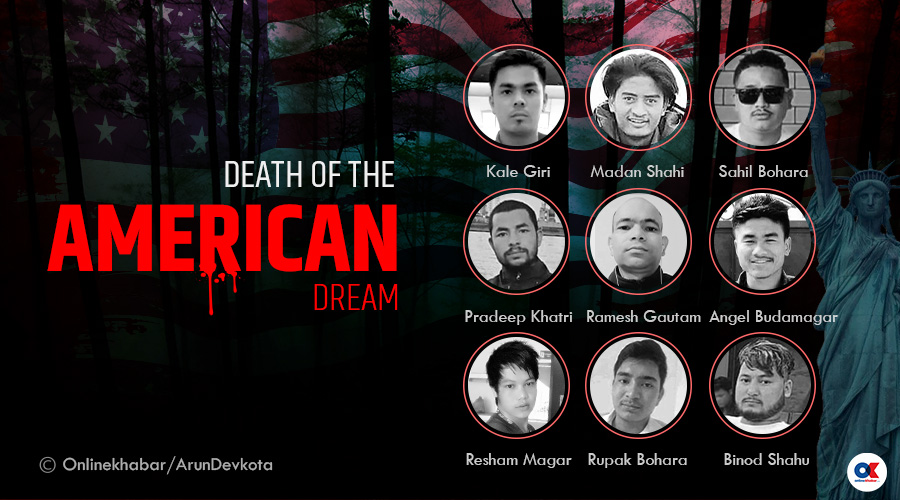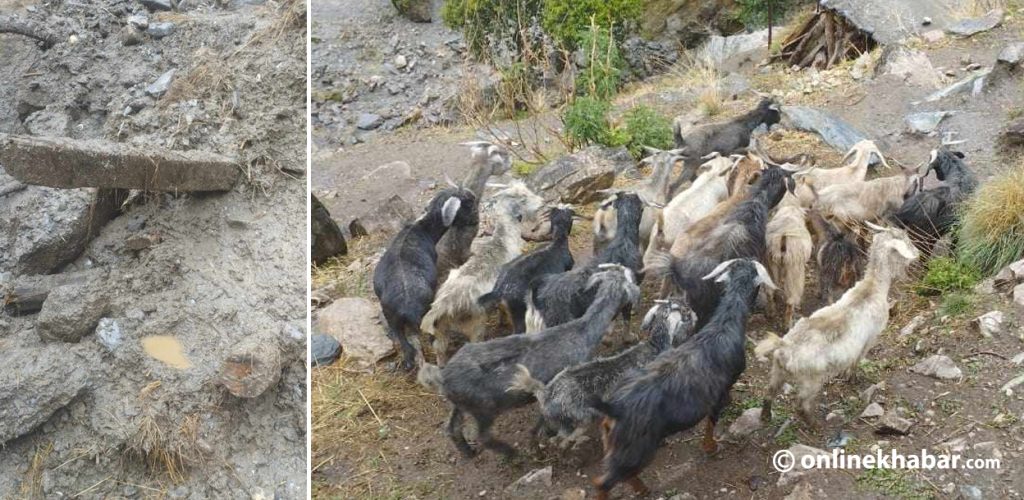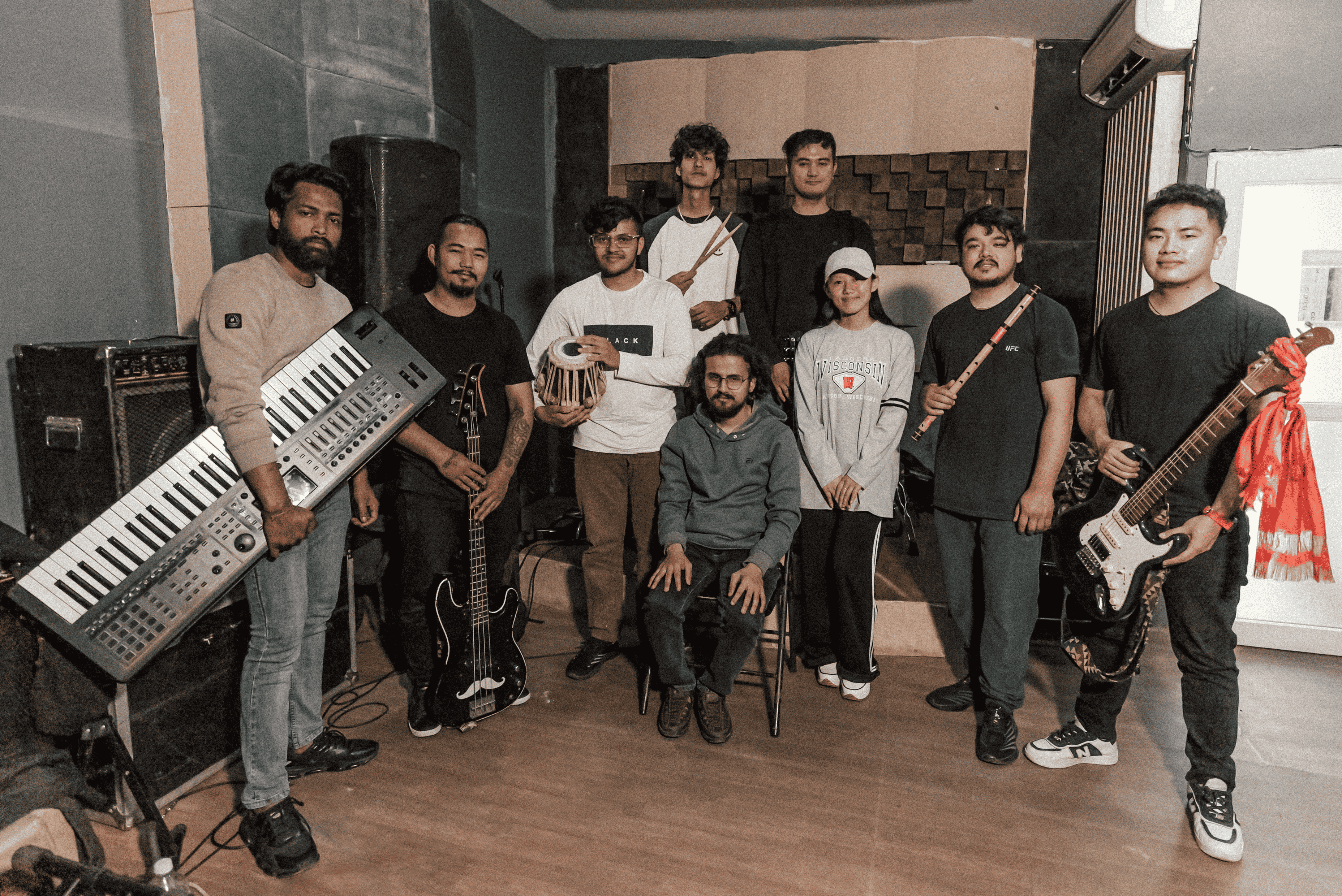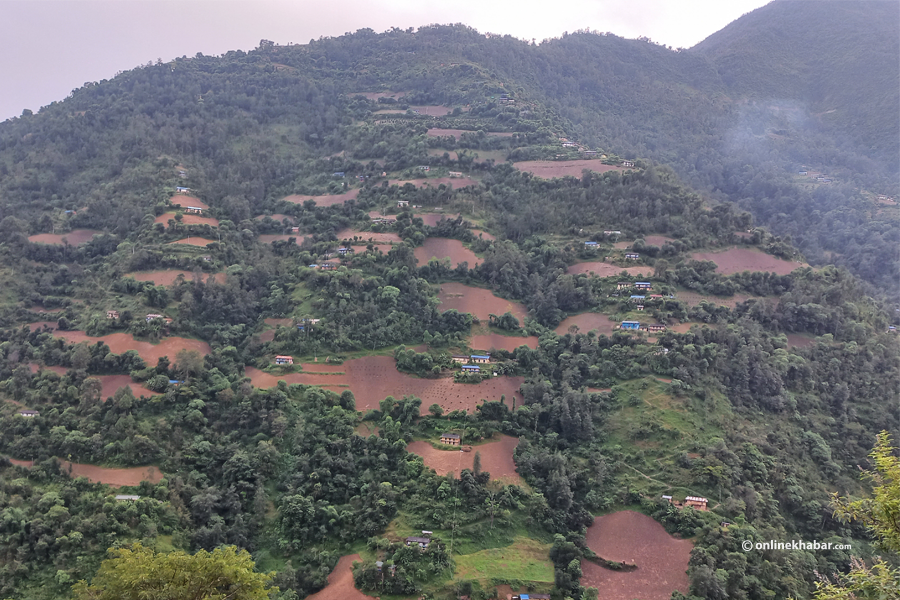
On any given day, 73-year-old Chandrakali Kusari, from Baki village of Bafikot rural municipality-6 in Rukum West, spends most of her time at home, staring at nothing. With every passing year, she is experiencing a sense of isolation in the village. “Everyone in the village has started going to the US, and now we, the elderly, are the only ones left behind.”
Almost everyone Kurasi knows—her daughter-in-law, sister-in-law, nephews, and grandsons—is in the US. Now, the 73-year-old woman is contemplating joining them in the US if her children are willing to take her. “My son assured me that he will arrange it, and I am ready to go.”
Like Kurasi, 78-year-old Darbe Kusari and 70-year-old Ghante Kusari also have a fear of being forced to leave their homes in the later stages of their lives. “Who would willingly abandon a home built on the foundations of their sorrows?” Darbe Kusari says.
However, Darbe’s son, Lokes Kurasi, who entered the US illegally three years ago by spending Rs 9 million, has expressed his intention to bring his parents over soon as well.
“There is no one in the village. With no one to perform the last rites after our passing, how can the elderly alone sustain this place?” he questions.
The Rukum district was divided into Rukum East and Rukum West within the Lumbini and Karnali provinces after the drafting of the new constitution. Presently, a majority of individuals from villages in the current Magma rural municipality have migrated to the US. The younger generation is noticeably scarce in the village, and a substantial number of those who remain are also seeking opportunities in the land of dreams.
In the villages of Syala, Baki, Magma, Dab, Godekada, Naduwa, and Gharikhola within the rural municipality, there are a total of 538 households. However, precise data on how many residents from these households have emigrated to the US is not available.
However, Manoj Kumar Adhikari, the chairperson of Ward 6, and Nar Bahadur Khatri, the chairperson of Ward 7 in Banphikot rural municipality, have reported that more than 300 individuals have left these villages alone. According to locals, nearly every household in these villages has one to four family members who have migrated to the US illegally, and some families have even relocated entirely to the promised land.
The American dream

To understand how the American dream made its way into the geographically isolated villages of Magma, Baki, Syala, Dab, and Godekada, one must rewind the clock by a decade.
A decade ago, a resident of Baki village Birkha Bahadur Khatri used to work as a teacher at the local Anu primary school. Nishan Pun, a cousin from Banphikot, had already entered the US illegally in the 2000s, stating that he had been displaced by the conflict.
With Pun’s assistance, Khatri also made the journey a decade ago, becoming the first person from his village to do so. In due course, his brothers, Bijay and Hare, also embarked on the same path, as did his parents, Khim Bahadur and Amrita. Their house now stands locked, a testament to the trend that continued to unfold.
“With the allure of the American dream and the promises of earning Rs 500,00 to 600,000 a month, the youth began searching for various ways to enter the US,” says ward chair Adhikari.
Out of the 13 households, only two do not have family members in the US who entered through illegal means. The situation has escalated to the point where the entire village seems to have been abandoned, as its residents have relocated to the US to chase their American dream.
Nearby, in Syala village, there are 100 households. Birkha Bahadur Khatri notes that not only students but also their teachers have chosen the same path, emigrating illegally, often paying substantial amounts to brokers and leaving their jobs and families behind.
Additionally, Nar Bahadur himself has sent his son to the US. He explained, “There are no employment opportunities in the village. Even those who receive an education here struggle to find decent jobs, and their wages are insufficient to provide for their basic needs.”
Breaking one’s back
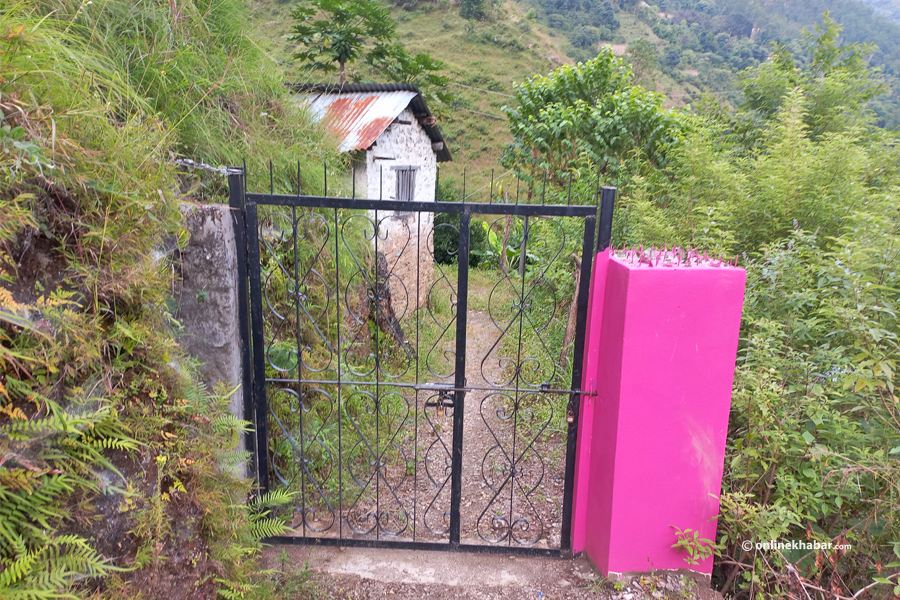
Upon visiting 18 households, it was evident that even ordinary families involved in farming were somehow sending their children to the US, spending roughly Rs 10 million. But the source of this capital and the means of accumulating it raises a lot of intriguing questions.
It is widely acknowledged in the village that they take an illegal route to reach the US. But, who are the brokers orchestrating these trips? Where does this illegal route lead, and what are the associated risks?
Those who remain here, especially housewives, have limited knowledge about the details of the process, except for the awareness that an illegal route is typically taken. They know that by investing between Rs 8.5 to 10 million, one may potentially reach the US in a matter of months.
Paul Singh Pun, a 57-year-old from Banphikot-7, is a farmer and, both of his sons have managed to reach the US. Singh explains that his son, Govind, entered the US illegally seven years ago by investing Rs 5.8 million. Then, five years later, his other son, Binod, followed suit, spending Rs 9.5 million. But how did Pun, a farmer, manage to pull this off?
He disclosed that he has spent over Rs 20 million, including the accumulated interest, to fulfil his son’s American dream.
“We didn’t have that much money at our disposal, so I took a loan from our relatives. I borrowed amounts like Rs 50,000, Rs 100,000, and even Rs 500,000 from neighbours and relatives to send them.”
Sher Bahadur Khatri, a 35-year-old resident of Magma, financed his 23-year-old brother, Prem Khatri’s journey to the US, which amounted to Rs 8.3 million. After 16 months of leaving home, Prem finally arrived in the US last month. He managed to gather the funds by seeking help from his neighbours, relatives, and friends.
According to ward chair Nar Bahadur Khatri, “The cost of the American dream has significantly escalated. A few years ago, it cost Rs 3 to 5 million per person, but now the rate has surged to Rs 8.5 million.”
He adds, they often take loans at an exorbitant interest rate of up to 33 per cent and become victims of loan sharks. The interests are paid to brokers, however, since brokers primarily make these arrangements through contacts who have already made the journey, many remain unaware of the brokers’ identities.
Dil Bahadur Batha’s family, from Magma, serves as a poignant example. His son took out loans twice, summing up to Rs 6.5 million, to secure a chance to fulfil his American dream. Initially, he paid Rs 3 million to the first broker, who unfortunately could not fulfil his promise, prompting his return midway. Undeterred, he sought the assistance of another broker, expending an additional Rs 3.5 million.
Eventually, after a gruelling seven-month journey, he arrived in the US two years ago. However, his dream was short-lived as he faced detention for 18 months before being deported. Now, he finds himself drowned in debt, as his Rs 6.5 million loan has grown to over Rs 10 million with interest.
The pull factor
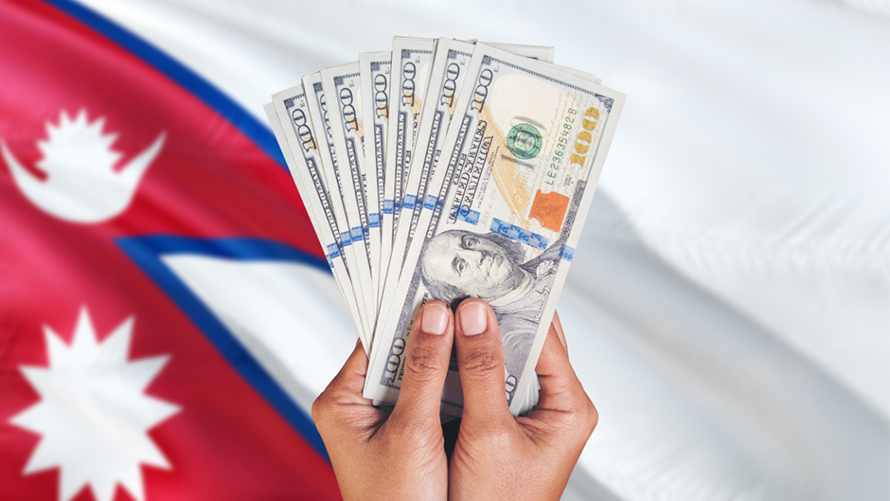
Meanwhile, ward chair Adhikari is taken aback to learn that even those who recently turned 18 had managed to enter the US through an illegal route. Among the many teenagers who have left the Baki village is 19-year-old Gopal Khatri. He left home to pursue a life in the US last October, investing more than Rs 8 million. But he is not alone who took the big step that early in his life.
A 22-year-old Nabin Kusari, from Magma village, embarked on his journey to the US on December 26, 2021, after paying Rs 8.5 million to a broker. Despite being initially promised that he could go for Rs 3.5 million, the broker disappeared after taking the money. As a result, Nabin sought the help of another broker and departed after paying an additional Rs 5 million. He finally arrived in the US in August, two years after initially setting out.
Educated young people from the village, including 22 teachers, 11 police officers, four soldiers, and many other government employees, are all leaving to fulfil their American dream. Adhikari says, “It seems the households are in a frantic competition to send their children to the US. Those remaining are here because they lack the money needed.”
In the seemingly deserted village, there is one young man named Prem Khatri in Banphikot-7. He has witnessed many of his peers leaving the village in search of opportunities in the US.
“Until two years ago, I had nine friends to go out with. But, all of them are now in the US. I am the only one left here.”
Prem Khatri received his medical education in Chitwan and is presently employed at the rural municipality’s clinic and medical store, earning approximately Rs 30,000 to Rs 35,000 per month. However, he voices his dissatisfaction, saying, “All my friends are doing well, earning somewhere around Rs 300,000 to Rs 600,000, and sending money back home. How can one expect to sustain a livelihood in the village with the income earned here?”
Cannot die in peace either
Meanwhile, the exodus to the US from these Rukum West villages has taken a significant toll on the social fabric. In these now-deserted villages, only elderly residents remain. The absence of young people has resulted in the disruption of social activities, customs, and traditions.
In the case of Magma village, there was no one to carry on their perform final rites of Kapil Dev Khanal, an old father who had sent both sons of one family to the US. Eventually, a relative took up the responsibility of performing the rituals.
Resident Bharat Bahadur Khatri predicts that within a few years, this scenario will become a common occurrence in every household. “What will become of the village when there is no one to fulfil the responsibilities for their parents?”
Madan Shah, a social leader in Rukum, reflects on how the pervasive American dream has exacted a significant social toll on these remote villages. He says, “The individual’s life who departs might end up with nothing,” expressing a mix of concern and sorrow, “but it’s the remote villages that are bearing a heavy cost.”





